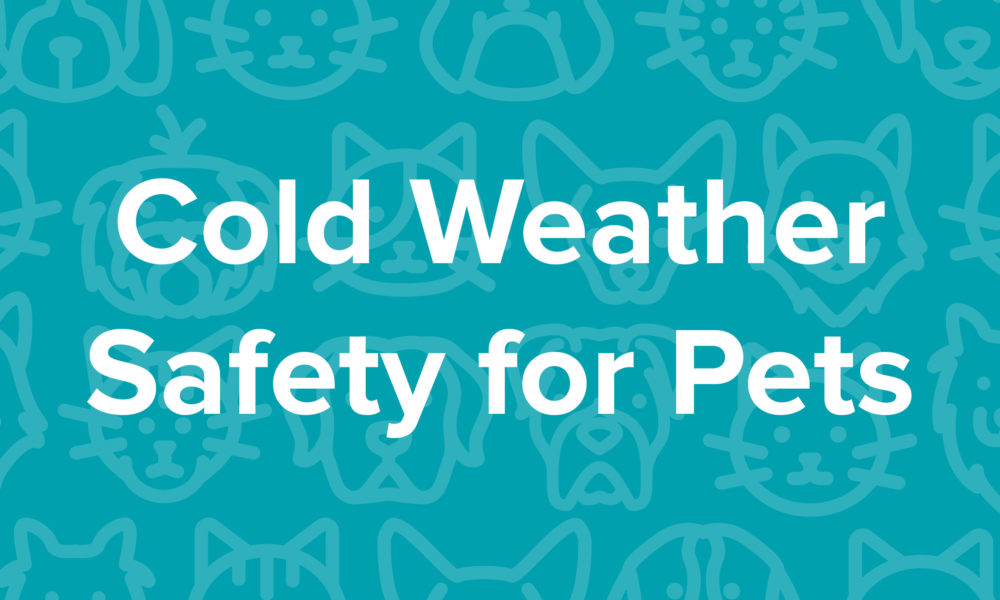Cold Weather Safety for Pets

Now that winter is here, you may be wondering how to keep your pets safe in the cold weather. Here are some cold weather tips for your cats & dogs:
Wellness. The first keep to keeping your pet safe in the cold is making sure that they are healthy. Have they had their annual check-up? Pets should be seen by a veterinarian once a year and if yours hasn’t been yet, now is a good time to make sure they are healthy enough for the cold weather.
Know their limits. Different pets have different tolerances to cold weather – just like people! Pets with a longer or thicker coat, like a collie dog, may have a higher tolerance to being out in the cold, while a shorter-haired pet, like a chihuahua, may need less time outside in the cold weather. Older pets may have difficulty walking on snow and ice and those with certain diseases have difficulty regulating their temperatures. If your pet doesn’t seem to tolerate the cold, you may need to take shorter walks or just let them out in the yard, if yours is fenced, for short potty breaks.
Don’t forget my snowsuit! If you have a pet with a shorter coat or fur, a sweater or coat may help keep them warm while outdoors. Have one or two available in case one gets wet because putting a wet coat on your dog will cool them down more quickly. Some pet owners also put boots on their pets to protect their paws.
Stay inside. With all that’s been going on for the past months, I’m sure no one wants to hear, ‘Stay inside’ again! Many people think that because they have a natural fur coat, pets are more resistant to the cold; however, pets can get hypothermia and frostbite too. Even if your pet has a higher tolerance for the cold, no pet should be left outside for long periods of time. Also, don’t leave your pet in a cold car. This is something you hear more in the summer but, being left in a cold car is just as dangerous as being left in a hot car.
Wipe your paws! This is especially important if you are out walking in the snow and ice. Dogs and cats can pick up ice melting pellets or antifreeze on their paws and that can be toxic if they lick their paws. Be sure to wipe their bellies too, especially if you have a cat or a low-to-the-ground dog like a dachshund! Check their paws frequently for cracks or other injuries that can caused by walking on snow and ice. Trimming the fur between their toes can help limit ice accumulation on their paws and rubbing petroleum jelly or similar pet-specific products into their pay pads before walking can help protect from ice melting pellets and other chemicals
Identification, please. Be sure that your pet has a collar with an updated identification tag and a microchip in case they get lost going over the river and through the woods to grandmother’s house! Pets that normally have no difficulty finding their way home may get lost because snow and ice can hide the scents that typically help them find their way.
Safety begins at home. Make sure your house is pet-proofed for winter. If you have space heaters, be careful that they are placed in areas where they cannot be knocked over and they should not be placed close to where your pet sleeps because contact with them can cause burns. If you have a pet bird, be sure to keep their cage away from drafty areas.
Have your heating system checked and install carbon monoxide detectors. This helps keep both animal and human family members safe!
Watch out for thin ice. Be careful when walking your dog near water, like ponds and streams. The surface may look frozen but may not be strong enough to hold your pet’s weight causing them to fall through. And if you try and save them, which most pet owners are likely to do, you could both be in danger.
Be prepared. This is not just good advice for Boy Scouts! During the winter there is the risk for storms and power outages. Maintain about a 5-day supply of food, water, and prescribed medicines for your pet.
Look out for your neighbors. If you have outdoor animals that you care for in your neighborhood, provide some shelter for them. A plastic storage bin on its side (without the cover!) or a thick cardboard box lined with a thick blanket can provide shelter for a cat or two. Put it in an area that is sheltered from the wind and leave out small amounts of food and water (changed regularly!).
Know the signs: If you are out with your pet and they are shivering, whining or looking for a place to burrow, these are signs of hypothermia and you should get your pet inside quickly. Frostbite may cause discoloration, blisters, and pain to the touch in the affected area. If you think your pet may have hypothermia or frostbite, contact your veterinarian immediately.
Stay warm, everyone!
